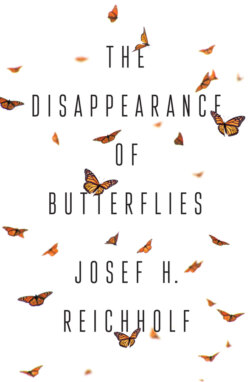Читать книгу The Disappearance of Butterflies - Josef H. Reichholf - Страница 12
Death’s head hawk-moth: a guest that can barely live with us anymore
ОглавлениеRight now, species that could have had a lasting impact on our children, if only they had got to know them, are disappearing. I am thinking of the great wonder that seized me one evening in early October, when a death’s head hawk-moth emerged from its pupa in a glass on my windowsill (see Photo 2). I had found it during the potato harvest. In the early 1960s, the potato fields in Lower Bavaria were predominantly harvested in the old-fashioned way. A horse pulled a plough with its share set at such an angle that, with the correct spacing, it created a deep furrow on one side, while a line of earth about two hand-widths higher than required was tipped over with the potato haulms. Some potatoes would thus escape harvest. We would look for these and then find others that were still encased in earth, which we would grub out by hand. In our Lower Bavarian dialect, we called this ‘Kartoffelklauben’ (‘potato grubbing’). The caterpillars of the death’s head hawk-moth, however, also now feed on potato plants in summer, since they are adapted to eating plants of the nightshade (Solanaceae) family. The potato plant, which originally came from South America, belongs to this poisonous plant family.
The distant origins of the death’s head hawk-moth are not a disadvantage; they actually work in its favour. This is because there is nowhere in the wild where the females of these massive moths will find any nightshade plants in such abundance and so conveniently grown, with open ground around the bushes, as in a potato field. Accordingly, soon after its large-scale introduction into Europe in the early seventeenth century, the American potato plant became a preferred alternative for this large African hawk-moth. We can assume that, prior to this, it flew here from the edge of tropical Africa only seldom, due to the lack of suitable forage plants. The bittersweet nightshade, Solanum dulcamara, did not offer much nutrition and grows so sparsely that even today the caterpillar of the death’s head hawk-moth is rarely found on it.
When these caterpillars are fully grown, they dig an elongated hollow slightly below the surface of the ground, in which they pupate. After several weeks of pupation, the mature moths emerge, and must try to fly south, across the Alps. They will not survive the winter to the north of them. My specimen was just such a fully grown caterpillar. I had housed him in a clean jam jar on a bed of garden soil and loosely covered him. From time to time I would spray the soil a little, so that the pupa would not dry out. With success: the newly emerged death’s head hawk-moth, whose wings were not yet fully unfurled, not quite covering the yellow and black-ringed plump abdomen, appeared massive to me. More so, when I let it crawl onto my index finger so that I could place it on the curtains. This way of holding it would allow it to fully stretch out its wings, so that they could become fit for flying. My goal was, after all, to release it at dusk, so that it could return to Africa. The mere thought that this plan might be successful and that I might contribute to it excited me tremendously.
However, the pale-yellow design on the back of its thorax that was supposed to remind me of a skull made little impression on me. No matter which way I looked, it did not resemble a skull at all. Perhaps I simply lacked the imagination to conjure one up (see Photo 3). Even now, while I write this, I find it hard to imagine that men in earlier times could have come up with such an odd idea. But those who can see a liver in the leaves of a liverwort, just because it is made up of three ‘lobes’ (not remotely resembling a liver) and can conclude from this that it must be good for liver trouble, will surely manage to make out a mini-skull in the back markings of this hawk-moth.
I am no longer certain what was going through my head at the time, but something happened that awakened the biologist in me once and for all. Our cat, which had been lying on the sofa and pretending to be fast asleep, in the way that cats do, approached and stretched its nose up to the death’s head hawk-moth on the curtains. The moment one of its whiskers touched the moth, the yellow and black-ringed abdomen flicked up between the wings and the moth let out a shrill squeak. The cat recoiled in shock, fell off the edge of the sofa, and took cover underneath it.
The combined effect of the wasp- or hornet-like markings and the squeaking sound, which extends to the ultrasound range, and which may thus be partially inaudible to the human ear, was an object lesson for me: no book, no account of such a procedure, could have explained in a more striking way what ‘aposematic colouring’ means and how it works. I was particularly affected, since I had found it so easy to coax the hawk-moth onto my fingertip and to place it on the curtains. Years later, whenever I stroked a bumblebee, coaxing it to produce a quiet humming, I would think back to this experience. This death’s head hawk-moth, of which there would be dozens more in my life (until the potato harvest was mechanized and no more pupae were to be found or no specimen was able to survive the rough handling of the harvesting machine) – this moth that emerged under my care – touched me (see Photo 4).
1 * In other words, butterflies and moths. ‘Lepidoptera’ is an order of insects that includes both. [Tr.]
